The educational attainment of a region’s workforce is an important driver of economic growth and labor market outcomes. On average, higher levels of education tend to coincide with a better performance in the labor market, including lower unemployment rates, higher labor force participation rates and higher wages. This issue of The Rocky Mountain Economist discusses the educational attainment of individuals in Colorado, New Mexico and Wyoming and their labor market outcomes.
Educational Attainment in the Rocky Mountain States
Educational attainment varies considerably across regions (Chart 1).i At the national level, 32 percent of individuals ages 25 to 64 have a bachelor’s or graduate degree, 30 percent have some college or an associate degree, 26 percent have a high school degree or equivalent and 12 percent have less than a high school degree. Among the Rocky Mountain States, Colorado has the highest percentage of individuals with some college or higher, including 40 percent with a bachelor’s or graduate degree and 31 percent with some college or an associate degree. Compared to the rest of the United States, Colorado has the third-largest share of individuals ages 25 to 64 with some college or higher, with only Minnesota and Washington, D.C., having larger shares. Wyoming has the largest share of individuals with some college or an associate degree as well as the smallest share of those with less than a high school degree when compared to the other Rocky Mountain States.
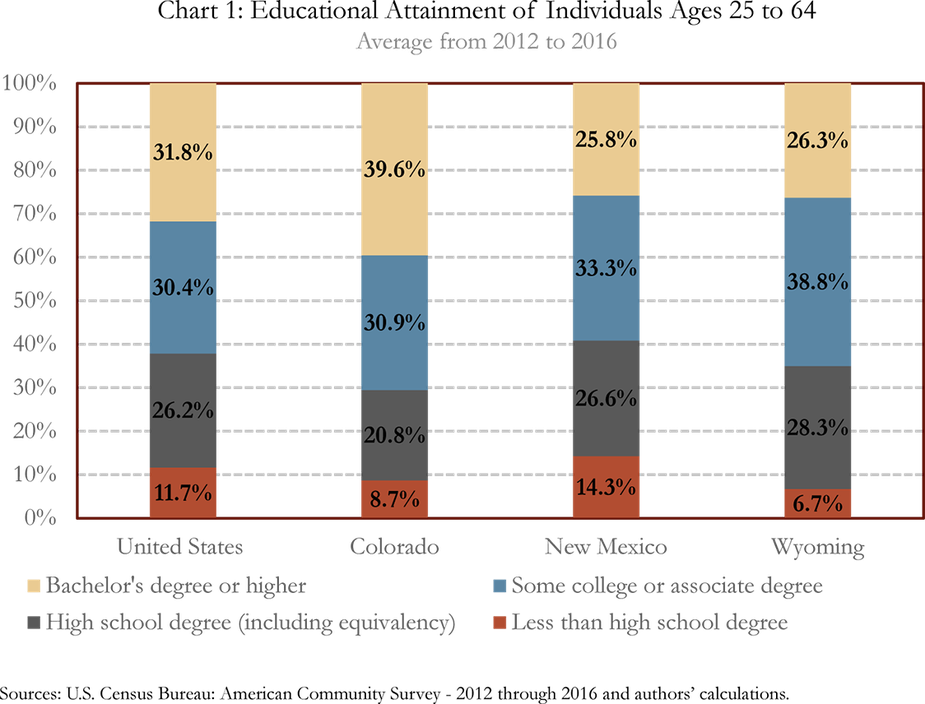
Although New Mexico’s share of those with a high school degree is similar to the national average, the proportion of individuals in New Mexico with less than a high school degree is considerably higher. In fact, New Mexico has the sixth-highest share of those with less than a high school degree in the United States.ii
The population of the United States over time has become steadily more educated. When the U.S. Census Bureau started collecting educational attainment data in 1940, 25 percent of the population 25 and older had completed at least a high school degree. This figure since has climbed to more than 88 percent. Similarly, only 5 percent of the population 25 and older had a bachelor’s degree or higher in 1940, rising to 33 percent by 2015.iii,iv
The Rocky Mountain States also experienced a sharp increase in the educational attainment of their population over the last half-century. Colorado and Wyoming experienced a significant rise in educational levels in the early 1960s, with a sharp decline in the share of individuals with a high school degree or less. Educational attainment continued to increase in Colorado and Wyoming in the 1970s and early 1980s, but at a slower and steadier pace. In New Mexico, on the other hand, the increase in educational attainment in the 1960s was less robust and the state instead experienced a slower, steady pace of increase in its education levels.v
The educational attainment of a state’s population is driven both by education attained within the state and also by the educational attainment of those who migrate to the region (Chart 2).vi Although the impact of migration can be minimal in some states, it can play a larger role in states that experience high levels of migration.
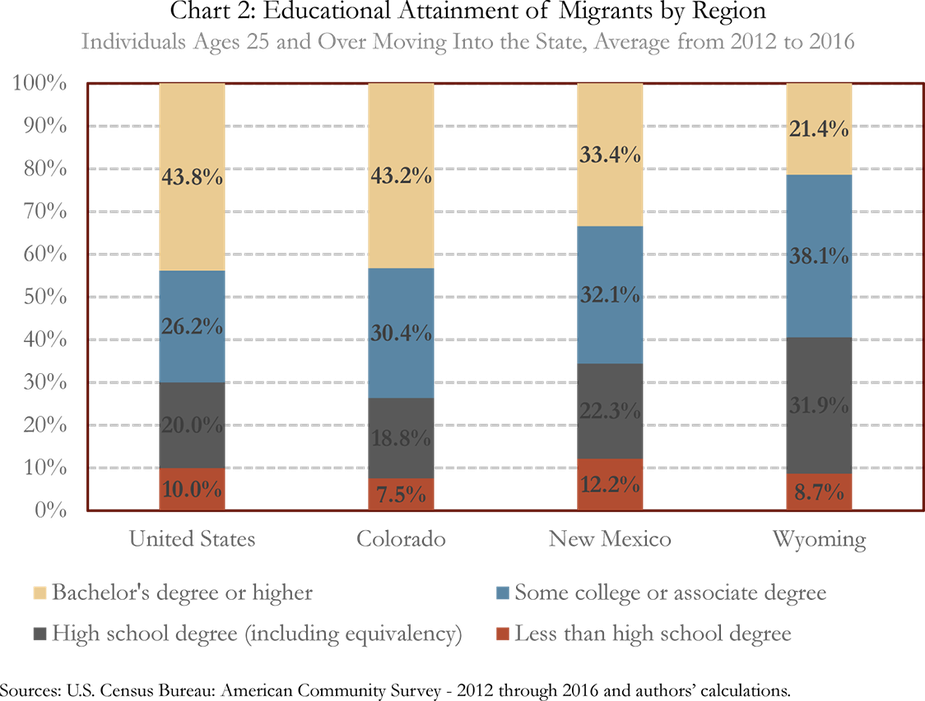
The share of individuals with a bachelor’s degree or higher that move into Colorado and New Mexico is higher than the current share in each state. Therefore, higher levels of migration to Colorado and New Mexico tend to raise the overall educational attainment within the state. By contrast, those migrating to Wyoming are less likely to have a bachelor’s degree or higher compared with others in the state, leading to lower levels of educational attainment in the state. Similarly, a lower share of less-educated migrants is moving to both Colorado and New Mexico, whereas Wyoming has a higher share moving into the state. The variation in the educational attainment of individuals moving into a state is driven in part by the industry mix and job prospects in each state.
Labor Market Participation by Educational Attainment
Labor market conditions typically worsen during recessions and improve during economic expansions for individuals across all levels of educational attainment. However, throughout the business cycle, individuals with higher levels of educational attainment tend to have better labor market outcomes, including lower unemployment rates, higher labor force participation rates and higher wages.
In the years prior to and during the 2007-09 recession, unemployment rates for individuals with less education were higher than rates for those with more education (Chart 3). Unemployment rates rose sharply across all education levels as the recession worsened, with unemployment rates eventually exceeding 15 percent for those with less than a high school degree and rates remaining just below 5 percent for those with a bachelor’s degree or higher. As the economy improved and the recovery took hold, unemployment rates started to decline. As of 2016, unemployment rates in the United States and Colorado were nearing pre-recession levels for all educational levels. In more recent data from the Bureau of Labor Statistics, unemployment rates have continued to fall. In May 2018, the unemployment rate in Colorado was 2.8 percent, well below its pre-recession low of 3.5 percent in May 2007. Similarly, the national unemployment rate has fallen to 3.8 percent, below its pre-recession trough of 4.4 percent and the lowest it has been since 2000.
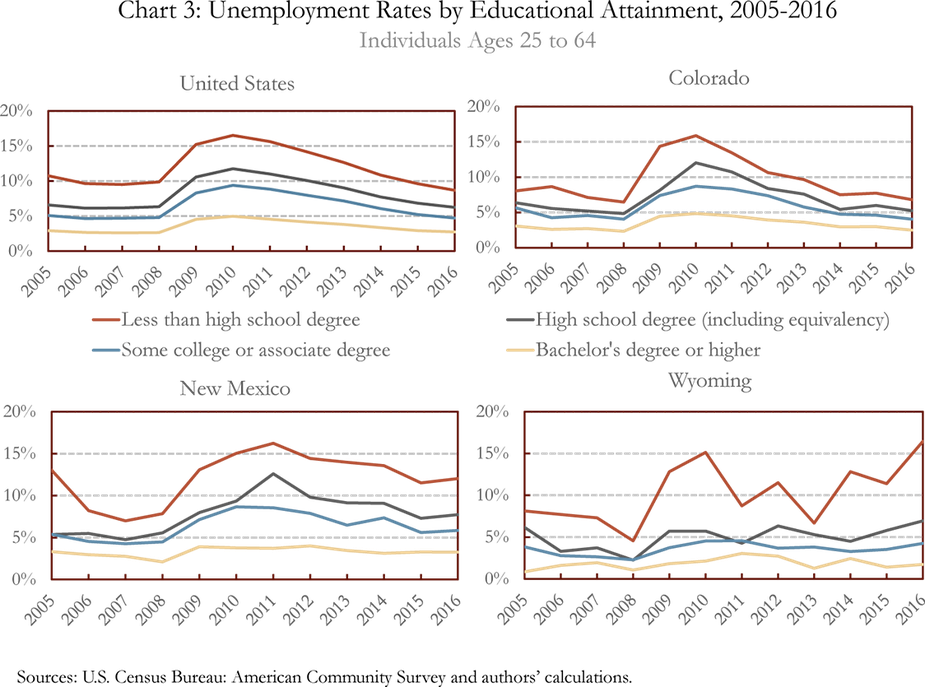
The economic recovery in New Mexico has been slower than the recovery in the United States and Colorado. Correspondingly, unemployment rates have been declining steadily in the state but at a relatively gradual pace. As of 2016, the unemployment rate for all education levels had improved since peak levels in mid-2010 but remained above their pre-recession lows. The economic expansion has accelerated in New Mexico since 2016, and the unemployment rate at the state level was 5.1 percent in May 2018, more than a percentage point below the previous year. However, the unemployment rate still remained elevated compared to its pre-recession trough of 3.7 percent in September 2007.
Unemployment rates in Wyoming have looked quite different from national rates since 2005. Except for individuals with less than a high school degree, unemployment rates in Wyoming have been much lower than national rates and have tended to follow activity in the energy sector more than the national business cycle. As of 2016, unemployment rates in Wyoming were above their pre-recession lows for all categories of educational attainment, with particularly elevated levels for those with less than a high school degree. Activity in the energy sector has improved since 2016, however, leading to lower unemployment rates across Wyoming. In May 2018, the unemployment rate was 3.7 percent—still above its pre-recession low of 2.7 percent but well below its peak of 7.1 percent in early 2010.
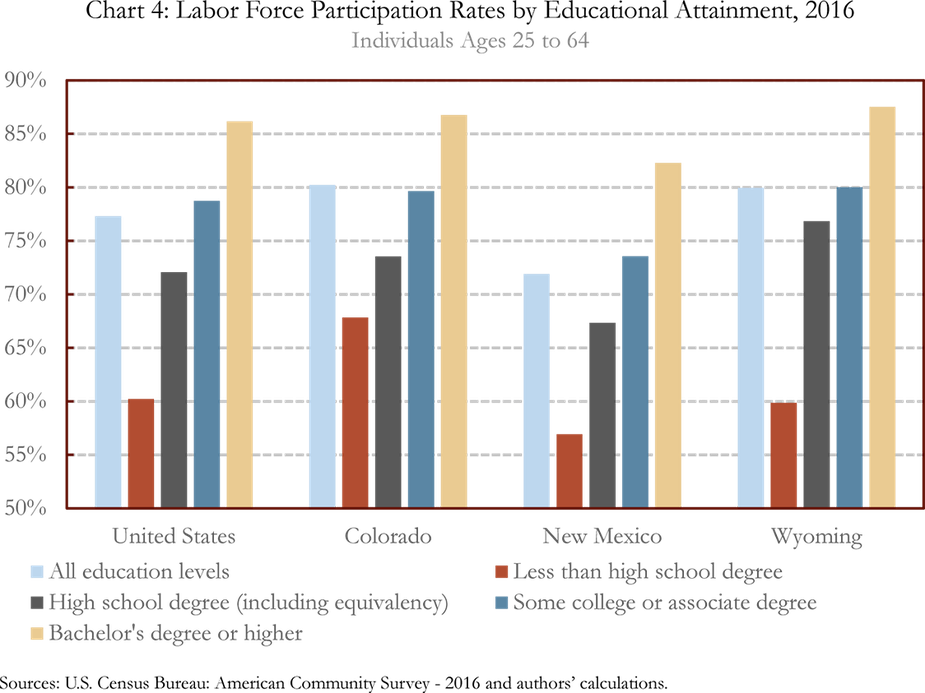
In addition to lower unemployment rates, those with higher levels of educational attainment typically have higher labor force participation rates (Chart 4). At the national level, 86.2 percent of individuals ages 25 to 64 with a bachelor’s degree or higher participated in the labor force in 2016. In contrast, only 60.2 percent of similarly-aged individuals with less than a high school degree participated in the labor force in 2016.vii As the recession worsened, many individuals dropped out of the labor force as jobs became increasingly difficult to find, leading to lower labor force participation rates across all levels of educational attainment. Although participation rates have increased modestly in the last year for individuals ages 25 to 64, labor force participation rates still remained below previous peak levels at the national level for all education levels through 2016 (Chart 5). Grouping together all individuals ages 25 to 64, labor force participation rates in 2016 were about 1.7 percentage points below previous peak levels in the United States and Colorado, about 3.8 percentage points lower in New Mexico and 2.9 percentage points lower in Wyoming. On average, labor force participation rates are closer to previous peak levels for individuals with a bachelor’s degree or higher, and in Colorado, participation rates for this group have actually surpassed previous levels.viii
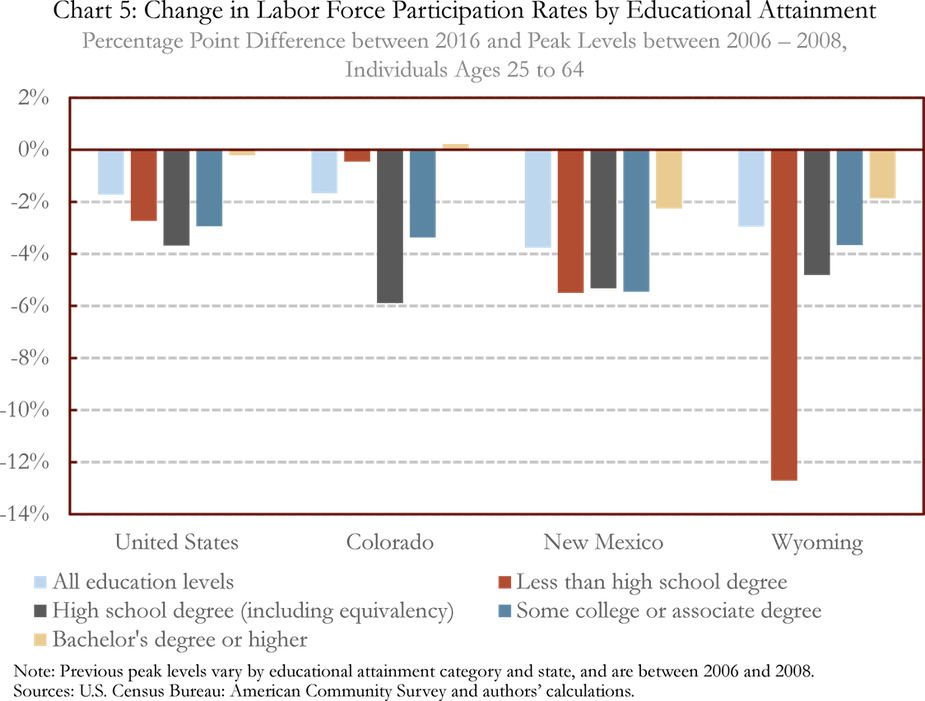
Earnings by Educational Attainment
Higher levels of education historically have led to higher earnings on average, and that trend persists today (Chart 6). At the national level, the ratio between the median earnings for those with a graduate or professional degree compared to those with less than a high school degree rose from about 2.7 in 1975 to about 4.2 in 2009. Since then, this ratio has fallen slightly to 3.4 in 2016.ix
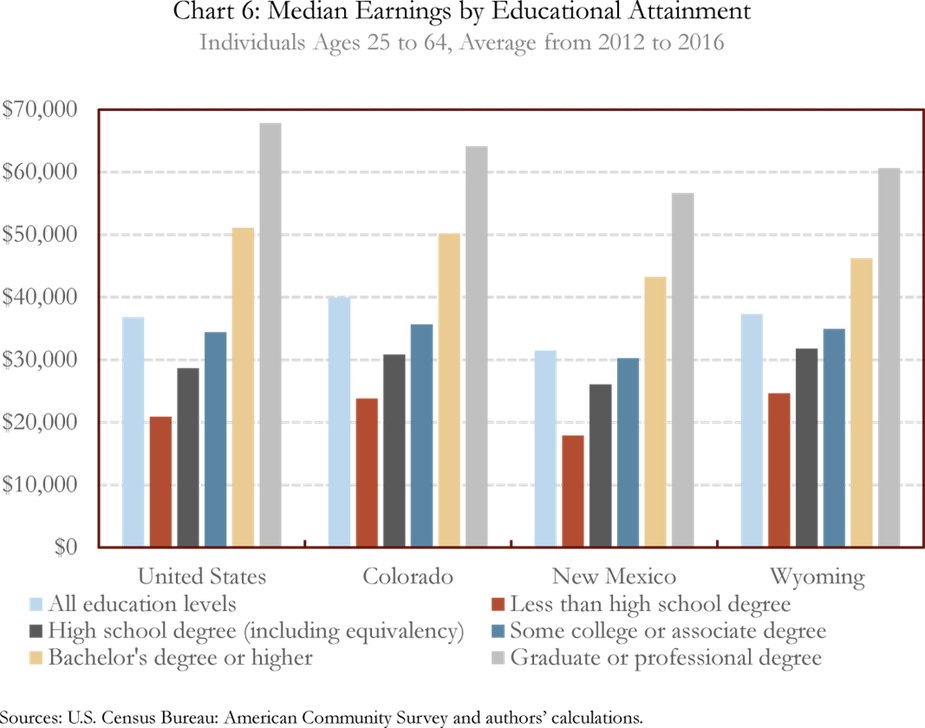
On average between 2012 and 2016, median earnings per worker were almost $40,000 in Colorado, $31,500 in New Mexico and $37,300 in Wyoming. In Colorado and Wyoming, median earnings for workers with a bachelor’s or graduate degree were slightly below national levels, while median earnings for those with an associate degree or less were slightly above national levels. In New Mexico, median earnings were below national levels across all educational attainment levels. Across all three Rocky Mountain States, the ratio between the median earnings for those with a graduate or professional degree compared with those with less than a high school degree was lower than at the national level.
Conclusion
Educational attainment plays an important role in regional economic growth and individual labor market outcomes. Since 1940, educational attainment has increased sharply in the United States and the Rocky Mountain States leading to productivity gains and higher standards of living. On average, individuals with a higher level of education experience lower unemployment rates, higher labor force participation rates and higher earnings.
End notes
i. Educational attainment refers to the highest level of education completed by an individual.
ii. U.S. Census Bureau (2016). Sex by Age by Educational Attainment for the Population 18 Years and Over, 2016 American Community Survey 5-year estimates. Retrieved from https://factfinder.census.gov/faces/nav/jsf/pages/searchresults.xhtml?refresh=t.
iii. These numbers differ slightly from Chart 1 as they are from a different source; specifically, the Current Population Survey–Annual Social and Economic Supplement.
iv. U.S Census Bureau, Ryan, Camille L., and Kurt Bauman. “Educational Attainment in the United States: 2015.” vol. p20-578. Web. https://www.census.gov/content/dam/Census/library/publications/2016/demo/p20-578.pdf.
v. Ibid.
vi. Chart 2 does not capture the share of those who have moved out of a state, but it does provide a glimpse of the education of those moving in. Net migration has been positive for Colorado for at least a few decades, but migration into Wyoming and New Mexico has been negative since 2014 and 2012, respectively. The United States numbers refer to the average educational attainment shares of those who no longer live in the same state (either moving from abroad or from a different state).
vii. U.S. Census Bureau (2016). Educational Attainment by Employment Status for the Population 25 to 64 Years, 2016 American Community Survey 1-year estimate. Retrieved from https://factfinder.census.gov/faces/nav/jsf/pages/searchresults.xhtml?refresh=t.
viii. However, labor force participation rates across the United States for all educational attainment categories are below their values from the early-90s with the exception of those with less than a high school degree whose rates have remained fairly flat over the last 40 years.
ix. Sarah Flood, Miriam King, Steven Ruggles and J. Robert Warren. Integrated Public Use Microdata Series, Current Population Survey: Version 5.0. [dataset]. Minneapolis: University of Minnesota, 2017. https://doi.org/10.18128/D030.V5.0.
